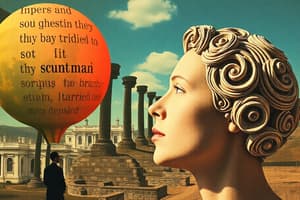Podcast
Questions and Answers
What defines an impossible figure in visual perception?
What defines an impossible figure in visual perception?
- An optical illusion that is easily recognizable without cognitive effort.
- A realistic depiction of a three-dimensional scene.
- A three-dimensional object that can be physically constructed.
- A two-dimensional figure interpreted as a three-dimensional object that cannot exist. (correct)
Which of the following is an example of an impossible figure?
Which of the following is an example of an impossible figure?
- A Cube
- A Sphere
- The Penrose triangle (correct)
- The Rainbow
Which artist is credited with creating the Penrose triangle?
Which artist is credited with creating the Penrose triangle?
- M.C. Escher
- Oscar Reutersvärd (correct)
- Pablo Picasso
- Vincent van Gogh
What type of visual illusion is characterized by perceived images that differ from objective reality?
What type of visual illusion is characterized by perceived images that differ from objective reality?
Which of the following best describes cognitive illusions?
Which of the following best describes cognitive illusions?
Which of the following is NOT a main type of visual illusion?
Which of the following is NOT a main type of visual illusion?
How does the brain process the information gathered by the eye in cases of visual illusions?
How does the brain process the information gathered by the eye in cases of visual illusions?
What is a key feature of physiological illusions?
What is a key feature of physiological illusions?
What is the main purpose of using trompe-l'oeil in art?
What is the main purpose of using trompe-l'oeil in art?
Which monocular cue indicates that one object is closer by appearing to obscure another?
Which monocular cue indicates that one object is closer by appearing to obscure another?
How does the perception of relative size affect our understanding of distance?
How does the perception of relative size affect our understanding of distance?
What role do shadows play in our perception of an object's solidity?
What role do shadows play in our perception of an object's solidity?
What is the effect of height in place on depth perception?
What is the effect of height in place on depth perception?
How does texture serve as a cue for depth perception?
How does texture serve as a cue for depth perception?
Which of the following is NOT a type of monocular cue for depth perception?
Which of the following is NOT a type of monocular cue for depth perception?
What is the relationship between apparent magnitude and perceived distance?
What is the relationship between apparent magnitude and perceived distance?
What does stereoscopic vision allow individuals to perceive?
What does stereoscopic vision allow individuals to perceive?
Which of the following correctly describes kinesthetic perception?
Which of the following correctly describes kinesthetic perception?
In the figure-ground phenomenon, how is the ground perceived?
In the figure-ground phenomenon, how is the ground perceived?
Which statement best describes the ambiguous image titled 'All Is Vanity'?
Which statement best describes the ambiguous image titled 'All Is Vanity'?
What does the ability to judge distances primarily rely on?
What does the ability to judge distances primarily rely on?
When observing a two-dimensional surface, how does kinesthetic perception manifest?
When observing a two-dimensional surface, how does kinesthetic perception manifest?
What characteristic is NOT typically associated with figure-ground perception?
What characteristic is NOT typically associated with figure-ground perception?
What type of vision primarily aids in spatial perception and depth judgment?
What type of vision primarily aids in spatial perception and depth judgment?
Flashcards are hidden until you start studying
Study Notes
Perception
- Figure-ground Perception: A visual phenomenon where an observer distinguishes an object (figure) from its background (ground); the ground is perceived as shapeless and continuous.
- Impossible Figures: Optical illusions that depict two-dimensional figures interpreted as three-dimensional objects that cannot exist in reality.
- Notable Examples:
- Escherian Stairwell
- M.C. Escher's "Relativity" and "Waterfall"
- Penrose Triangle, first created by Oscar Reutersvärd in 1934.
Visual/Optical Illusions
- Defined as images perceived differently than objective reality, creating a disparity between visual perception and physical measurements.
- Types of Optical Illusions:
- Literal Illusions: Create images distinct from the actual objects.
- Physiological Illusions: Result from excessive stimulation (brightness, color, movement).
- Cognitive Illusions: Stem from unconscious inferences made by the brain.
Spatial Perception
- Utilizes two eyes to perceive depth and dimensions, requiring shifts in focus.
- Types of Vision:
- Stereoscopic Vision: Overlaps slightly different views to create an illusion of depth, essential for judging distances.
- Kinesthetic Vision: Involves movement of the eye across a two-dimensional surface, organizing separate parts into a cohesive whole.
Examples of Figure-ground Perception
- "All Is Vanity": An optical illusion by Charles Allen Gilbert showing either a woman with a mirror or a skull, highlighting how distance affects perception.
Trompe-l'oeil Technique
- An art method that creates realistic imagery to trick the eye into perceiving three-dimensional objects from two-dimensional representations.
- Similar illusion technique used in architecture known as forced perspective.
Perception of Space, Depth & Distance
- Shadows play a crucial role in perceiving depth and solidity of objects.
- Monocular Cues for Depth Perception:
- Superposition: Nearer objects block views of farther objects.
- Apparent Magnitude & Relative Size: Smaller objects appear further away in a group of similarly sized items.
- Height in Place: Higher-placed objects on a flat plane seem farther away.
- Texture Gradient: Finer textures suggest more distance; more irregular or coarse textures appear closer.
Studying That Suits You
Use AI to generate personalized quizzes and flashcards to suit your learning preferences.




